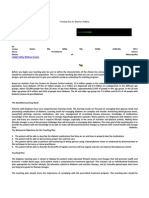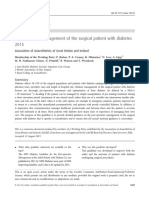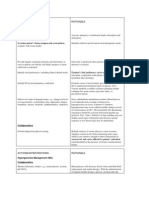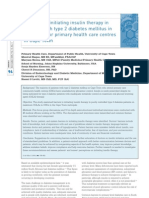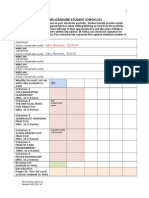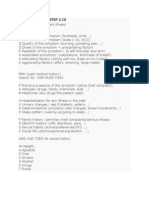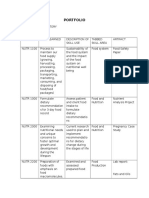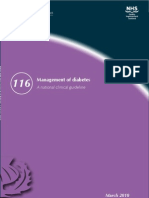Ebp Journal - Dka
Ebp Journal - Dka
Uploaded by
api-301861602Copyright:
Available Formats
Ebp Journal - Dka
Ebp Journal - Dka
Uploaded by
api-301861602Original Title
Copyright
Available Formats
Share this document
Did you find this document useful?
Is this content inappropriate?
Copyright:
Available Formats
Ebp Journal - Dka
Ebp Journal - Dka
Uploaded by
api-301861602Copyright:
Available Formats
Running head: DIABETIC KETOACIDOSIS PROTOCOL
Diabetic Ketoacidosis Protocol
Andrea R VanPortfliet
Ferris State University
DIABETIC KETOACIDOSIS PROTOCOL
This article discusses the difference between the different ways to treat a patient who
comes into the hospital with diabetic ketoacidosis. It focuses on the difference of care with using
an evidence based practice protocol and using the usual standard of care. Since most patients
who come in with DKA are seen in the ER first, it is important for the nurses to know the
protocol to treat this patient. Many hospitals do not have a standardized protocol set up for this
type of situation so it can cause confusion among the nurses involved in treatment. This study
was meant to prove that hospitals that adhere to the evidenced-based guidelines, provide better
care and outcomes for their patients.
During this study, data was collected in a retrospective review of charts and
documentation of patients. Data was collected on the standard care, and then the hospital set in
place and trained the nurses on a set protocol. Data was also collected after the protocol was set
in place. The protocol being used was the ADAs most recent EBP recommendations on treating
DKA. Patients selected for this study were non-pregnant, 18 or older, and with diabetes mellitus
1 or diabetes mellitus 2. Patient characteristics including, race, gender, age, diabetes type, and
others were reviewed to ensure both groups were at a similar baseline. Data collected for
comparison was severity of acidosis, electrolyte levels, average time to dextrose replacement,
average time to insulin administrations, and much more.
The results of this study show that a hospital using the evidenced based practice protocol
will decrease treatment times, therefore improve the care for a patient with diabetic ketoacidosis.
Decreasing the treatment time means we are decreasing the risk for complications and declining
health. This is done through timely intravenous fluid replacement for dehydrations, AG closure,
and dextrose and potassium replacement. The patients who were treated with usual standard of
care, had an AG closure time on average 4 hrs longer. Overall, patients who were treated with
protocol received better care and improved faster.
DIABETIC KETOACIDOSIS PROTOCOL
Limitations are variables that can somehow change the outcome of the study, but are out
of the researchers control. One of these is that nurses and doctors are always learning new
protocols and practices, so they were learning many other things along with this DKA protocol.
This could be why some patients were only partially treated following the protocol, which is
another limitation. Every nurse will treat a patient differently and follow protocol differently.
This can affect how the patient is treated and the outcome. With more time and education on this
protocol, care would become more consistent for each patient.
This study included all ages and genders, but the outcome could have been different if
they had focused on one age group or gender. Younger adults may respond differently to the
same treatment as an older patient, and same with males and females. Each patient needs to be
treated differently depending on their size, weight, and condition.
A plan on care should be set up to make it easier for the nurses. It needs to be taken into
account that each patient will needed to be treated differently depending on their state of health,
age, and if they have any other diseases to worry about. A few nursing diagnoses and
interventions would be fluid volume deficit related to dehydration from hyperglycemia.
Interventions would be monitor intake and output, give oral and IV fluids, and watch vitals.
Imbalanced Nutrition related to insufficient of insulin is another nursing diagnosis for DKA.
Interventions would include patient education about diet and insulin, listen to bowel sounds to
assess digestive function, and working with team members to design proper diet for the patient.
The last nursing diagnosis for this issue could be knowledge deficit of the disease and treatment.
Some interventions would be education about diabetes and how to manage using the teach-back
method and providing written instructions on types of insulin and when to use.
I think that this study holds a lot of relevance to the nursing world. Nurses always want to
treat their patients in the most effective and efficient ways. If developing a protocol to treat
diabetic ketoacidosis patients decreases the time needed to treat and reducing complications with
DIABETIC KETOACIDOSIS PROTOCOL
DKA, than it should be used. I think it is important for nurses to stay up to date on current
evidenced based practice studies because it can help improve care for our patients.
References
Evans, Kathryn, Julie Thompson, Susan E. Spratt, Lillian F. Lien, and Allison Vorderstrasse.
"The Implementation and Evaluation of an Evidence-Based Protocol to Treat Diabetic
DIABETIC KETOACIDOSIS PROTOCOL
Ketoacidosis A Quality Improvement Study." Advanced Emergency Nursing
Journal 36.2: 189-98. Web. 8 July 2015.
You might also like
- Diabetic Patient Teaching PlanDocument6 pagesDiabetic Patient Teaching Plantanvir24sami58% (12)
- Childhood Obesity Apa PaperDocument13 pagesChildhood Obesity Apa Paperapi-3018616020% (1)
- Gestational Diabetes Brochure ENGDocument2 pagesGestational Diabetes Brochure ENGP Zamora100% (2)
- Teaching Plan For Diabetes MellitusDocument14 pagesTeaching Plan For Diabetes MellitusAshleeNicole Fariñas Tugade100% (4)
- Teaching Plan For Diabetes MellitusDocument5 pagesTeaching Plan For Diabetes MellitusWebster Claveria100% (5)
- UVA Family Medicine Qbank Answers PDFDocument101 pagesUVA Family Medicine Qbank Answers PDFjamesmgang100% (1)
- BSAVA Manual of Veterinary Nursing 1999Document303 pagesBSAVA Manual of Veterinary Nursing 1999Takács Györgyi100% (1)
- Journal of Diabetes Research - 2024 - Zinn - Redefining Diabetes Care Evaluating the Impact of a Carbohydrate‐ReductionDocument15 pagesJournal of Diabetes Research - 2024 - Zinn - Redefining Diabetes Care Evaluating the Impact of a Carbohydrate‐ReductionPratham VermaNo ratings yet
- Clinical Inertia in T2DM ManagementDocument11 pagesClinical Inertia in T2DM ManagementEva GabrielNo ratings yet
- Diabetes Management Paper-2Document5 pagesDiabetes Management Paper-2api-284596154No ratings yet
- Case Study Orientation SlidesDocument88 pagesCase Study Orientation SlidesJoseph Emmanuel CandaNo ratings yet
- Dka Management of Dka in Adults March 20101Document24 pagesDka Management of Dka in Adults March 20101djizhieeNo ratings yet
- Veverka2016 Protokol IV FluidDocument6 pagesVeverka2016 Protokol IV FluidIrkania PasangkaNo ratings yet
- Case Study - Diabetic KetoacidosisDocument78 pagesCase Study - Diabetic KetoacidosisEnriqueNo ratings yet
- 174 Dme 13603Document21 pages174 Dme 13603tereNo ratings yet
- Arun ArticleDocument8 pagesArun Articleslacker77725No ratings yet
- Goebel Fabbri 2008 Diabetes and Eating DisordersDocument3 pagesGoebel Fabbri 2008 Diabetes and Eating Disordersfilmstudio0510No ratings yet
- Jurnal Icha Periop 4Document14 pagesJurnal Icha Periop 4ichamarichaNo ratings yet
- PD Nursing Update ProposalDocument6 pagesPD Nursing Update ProposalUri Perez MontedeRamosNo ratings yet
- Nursing Care Plan "Diabetes"Document8 pagesNursing Care Plan "Diabetes"Senor Senior100% (1)
- Insulin Adherence Behaviours and Barriers in The Multinational Global Attitudes of Patients and Physicians in Insulin Therapy StudyDocument8 pagesInsulin Adherence Behaviours and Barriers in The Multinational Global Attitudes of Patients and Physicians in Insulin Therapy StudyJohn LópezNo ratings yet
- Independent: Actions/Interventions RationaleDocument8 pagesIndependent: Actions/Interventions RationalePedro SorianoNo ratings yet
- Dhatariya Et Al-2012-Diabetic Medicine PDFDocument14 pagesDhatariya Et Al-2012-Diabetic Medicine PDFkillingeyes177No ratings yet
- Diabetes + Dialysis: A Medical Education Institute/Life Options PublicationDocument8 pagesDiabetes + Dialysis: A Medical Education Institute/Life Options PublicationTareq AzizNo ratings yet
- Transitions of Care in Pharmacy Casebook 1 -online Edition Laressa Bethishou - eBook PDF 2024 scribd downloadDocument69 pagesTransitions of Care in Pharmacy Casebook 1 -online Edition Laressa Bethishou - eBook PDF 2024 scribd downloadkaashekarajz100% (2)
- NSRG 258 Principles of NursingDocument11 pagesNSRG 258 Principles of NursingMayaka AmosNo ratings yet
- Weaningfromparenteral Nutrition: Andrew UklejaDocument26 pagesWeaningfromparenteral Nutrition: Andrew UklejaJosebeth RisquezNo ratings yet
- HypoglikemiaDocument7 pagesHypoglikemiaNurul MardiahNo ratings yet
- Lifestyle Choices and Chronic Kidney Disease:: Dietary Habits and Nutritional ManagementDocument6 pagesLifestyle Choices and Chronic Kidney Disease:: Dietary Habits and Nutritional ManagementBalwayan, January DwayneNo ratings yet
- Pi Is 2468024923000499Document15 pagesPi Is 2468024923000499Juan Carlos BarriNo ratings yet
- Quality Improvement Project.Document7 pagesQuality Improvement Project.rhinoNo ratings yet
- Glycaemic Control On Nutritional Support FindingDocument2 pagesGlycaemic Control On Nutritional Support Findingmutiara prasastiNo ratings yet
- Hypoglychemia AdultsDocument32 pagesHypoglychemia AdultsshutekiNo ratings yet
- Insulina Temprana en CetoacidosisDocument8 pagesInsulina Temprana en CetoacidosisMaria Ocotlan Gonzalez herreraNo ratings yet
- DIET in Chronic Kidney DiseaseDocument3 pagesDIET in Chronic Kidney Diseaseatul_desai_3No ratings yet
- Page 1994Document8 pagesPage 1994eric.r.c1701No ratings yet
- Impact of Intensive Nutritional Education With Carbohydrate Counting On Diabetes Control in Type 2 Diabetic PatientsDocument7 pagesImpact of Intensive Nutritional Education With Carbohydrate Counting On Diabetes Control in Type 2 Diabetic PatientsReeds LaurelNo ratings yet
- Practical Guide To Inpatient Glycaemic Care - V2 2020Document115 pagesPractical Guide To Inpatient Glycaemic Care - V2 2020shahirahNo ratings yet
- We Need Minimally Disruptive Medicine: AnalysisDocument3 pagesWe Need Minimally Disruptive Medicine: Analysisapi-252646029No ratings yet
- Guias DM1 PDFDocument127 pagesGuias DM1 PDFLalo LozanoNo ratings yet
- Protokol Sleading ScaleDocument9 pagesProtokol Sleading Scaleb3djo_76No ratings yet
- The Most Frequent Diagnosis On Patients Undergoing HemodialysisDocument5 pagesThe Most Frequent Diagnosis On Patients Undergoing HemodialysisChristine Rose EmNo ratings yet
- InsulinDocument17 pagesInsulinveraNo ratings yet
- Document 8Document7 pagesDocument 8mraza17No ratings yet
- Dabetes InglesDocument10 pagesDabetes InglesIsabelNo ratings yet
- Frailty Jbds Ipfinal 28 10 19Document70 pagesFrailty Jbds Ipfinal 28 10 19Xylia TocaoNo ratings yet
- Impact of A Nurse Short Message Service Intervention For Patients With DiabetesDocument6 pagesImpact of A Nurse Short Message Service Intervention For Patients With DiabetesFatima Akbar.No ratings yet
- Haider Kadhum RaddamDocument7 pagesHaider Kadhum Raddamhaider kadhum RaddamNo ratings yet
- Nutritional Intervention in Chronic Kidney Disease: EditorialDocument2 pagesNutritional Intervention in Chronic Kidney Disease: EditorialDaniel DarmawanNo ratings yet
- 5 How Do You Implement The Diet - A. G. Christina Bergqvist. G. Christina BergqvistDocument12 pages5 How Do You Implement The Diet - A. G. Christina Bergqvist. G. Christina BergqvistX LiNo ratings yet
- FastingDocument7 pagesFastingཛཉཀབསNo ratings yet
- Gastroenteritis+in+children May2014+Document17 pagesGastroenteritis+in+children May2014+Naily HosenNo ratings yet
- HESI Case Study Diabetes Type 1 Clinical Medical Surgical 1Document5 pagesHESI Case Study Diabetes Type 1 Clinical Medical Surgical 1Rosemenite AugustinNo ratings yet
- Medi 103 E37920Document6 pagesMedi 103 E37920kikikartika292No ratings yet
- DiabDocument6 pagesDiabjuniorebindaNo ratings yet
- (Osborn) Chapter 53 Learning Outcomes (Number and Title)Document33 pages(Osborn) Chapter 53 Learning Outcomes (Number and Title)Kitties100% (1)
- Pdep Fms BrieffinalDocument45 pagesPdep Fms BrieffinalZarif SyafiqNo ratings yet
- Standards of Medical Care in Diabetes-2011: Merican Iabetes SsociationDocument51 pagesStandards of Medical Care in Diabetes-2011: Merican Iabetes SsociationYazmin CamachoNo ratings yet
- Diabetic Ketoacidosis Case PresentationDocument37 pagesDiabetic Ketoacidosis Case PresentationNathan Vince Cruz100% (2)
- CLINICAL ACTIVITIES 1 RenalDocument6 pagesCLINICAL ACTIVITIES 1 Renaliqmal irfamimiNo ratings yet
- 173 Nep 12837Document25 pages173 Nep 12837tereNo ratings yet
- Care of The Client With Pulmonary Tuberculosis Utilizing Orem's TheoryDocument13 pagesCare of The Client With Pulmonary Tuberculosis Utilizing Orem's TheoryRazel Kinette AzotesNo ratings yet
- DM Self AssessmentDocument6 pagesDM Self AssessmentruguNo ratings yet
- Prognostication: Principles and PracticeFrom EverandPrognostication: Principles and PracticeRating: 5 out of 5 stars5/5 (1)
- 450 Reasearch PresentationDocument1 page450 Reasearch Presentationapi-301861602No ratings yet
- Portfolio Check ListDocument2 pagesPortfolio Check Listapi-301861602No ratings yet
- Nurs 240 PaperDocument4 pagesNurs 240 Paperapi-301861602No ratings yet
- Hyperthyroidism BrochureDocument2 pagesHyperthyroidism Brochureapi-301861602No ratings yet
- Using Good Body Mechanics: Posted by February 28, 2013share This PostDocument63 pagesUsing Good Body Mechanics: Posted by February 28, 2013share This PostJeralyn PlaresanNo ratings yet
- Topic 15. Cutaneous Manifestations of Diabetes MellitusDocument2 pagesTopic 15. Cutaneous Manifestations of Diabetes MellitusLara PazNo ratings yet
- The Natural Way To A Healthy HealingDocument111 pagesThe Natural Way To A Healthy HealingAnjanaNo ratings yet
- Roth 10e Nclex Chapter 17Document4 pagesRoth 10e Nclex Chapter 17jennaaahhhNo ratings yet
- Diabetes TBDocument26 pagesDiabetes TBella il ji mayNo ratings yet
- HNTR 1153 - Internet Diabetes Risk TestDocument1 pageHNTR 1153 - Internet Diabetes Risk TestSukmaNo ratings yet
- Red Book 9th Edition Lifecycle Charts v2Document2 pagesRed Book 9th Edition Lifecycle Charts v2Shahriar Kabir DaneNo ratings yet
- Organ Transplantation Legal, Ethical and Islamic Perspective in NigeriaDocument13 pagesOrgan Transplantation Legal, Ethical and Islamic Perspective in NigeriaMuaz ShukorNo ratings yet
- A Case of Metabolic Syndrome: Rabia Khatoon Mmed (Fammed, Um), Khoo Ee Ming MRCGP, FammDocument4 pagesA Case of Metabolic Syndrome: Rabia Khatoon Mmed (Fammed, Um), Khoo Ee Ming MRCGP, FammalmaNo ratings yet
- Diabetes in PregnancyDocument88 pagesDiabetes in PregnancyKathleenZunigaNo ratings yet
- English-Spanish Health Related DictionaryDocument77 pagesEnglish-Spanish Health Related DictionaryIsabel Cristina JaramilloNo ratings yet
- Step 2 CS MnemonicsDocument12 pagesStep 2 CS Mnemonicsinfinitefps100% (2)
- Huron Hometown News - July 26, 2012Document8 pagesHuron Hometown News - July 26, 2012schaffnerpubNo ratings yet
- HonkDocument22 pagesHonkSitta Grewo LiandarNo ratings yet
- ObesityxxxDocument45 pagesObesityxxxAnandhi S SiddharthanNo ratings yet
- Treatment of Hypertension in Adults With Diabetes: Position StatementDocument3 pagesTreatment of Hypertension in Adults With Diabetes: Position StatementVera WatiNo ratings yet
- Teratogenic ItyDocument8 pagesTeratogenic ItyValentin IanaNo ratings yet
- 1 - Overview of Diabetes CPG 2015Document26 pages1 - Overview of Diabetes CPG 2015Andi Pangeran Arya100% (1)
- SyllabusDocument76 pagesSyllabusamattirkeyNo ratings yet
- Portfolio 1Document9 pagesPortfolio 1api-338399833No ratings yet
- 13 Anion Gap Metabolic AcidosisDocument42 pages13 Anion Gap Metabolic AcidosisJoel Topf100% (3)
- Management of DiabetesDocument170 pagesManagement of DiabetesWan AzinuddinNo ratings yet
- Metformin MetforminDocument6 pagesMetformin Metforminphia29No ratings yet
- Avaaram PooDocument3 pagesAvaaram PooThirtha KumarNo ratings yet
- The Acceptability of Manzanita Fruit As A TeaDocument17 pagesThe Acceptability of Manzanita Fruit As A TeaRinalyn MedranoNo ratings yet
- Case Study On Diabetis and AnemiaDocument21 pagesCase Study On Diabetis and AnemiaAfna SyedNo ratings yet
- Carbohydrate Metabolism Disorders Stom 10-11Document61 pagesCarbohydrate Metabolism Disorders Stom 10-11Artem GrigoryanNo ratings yet




